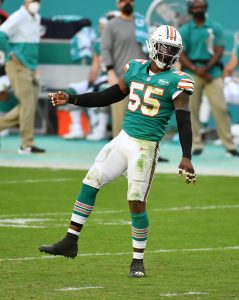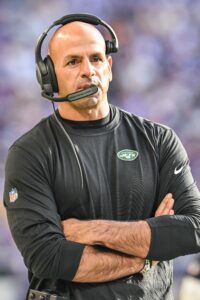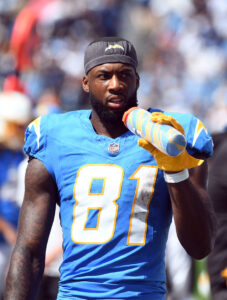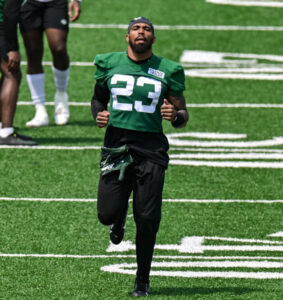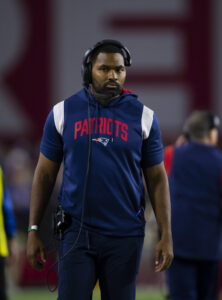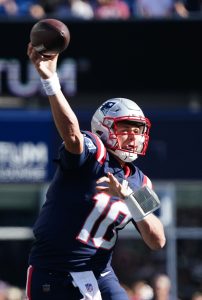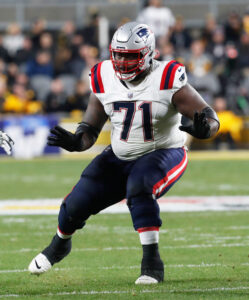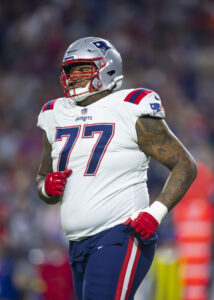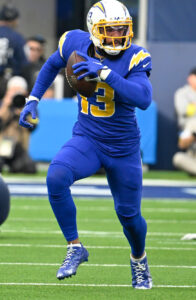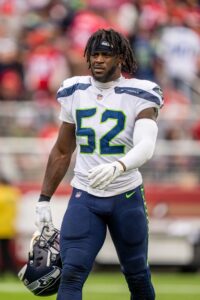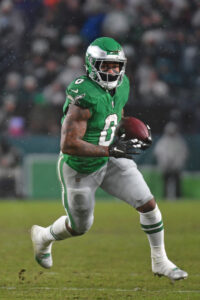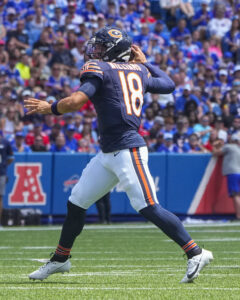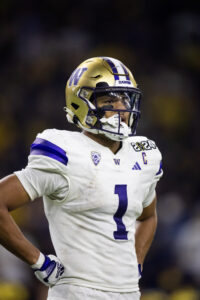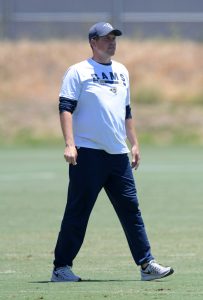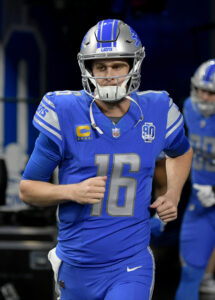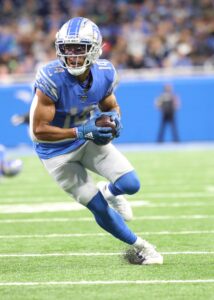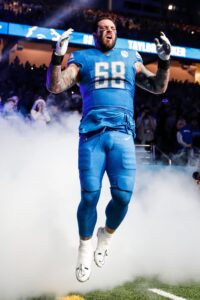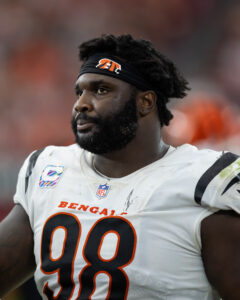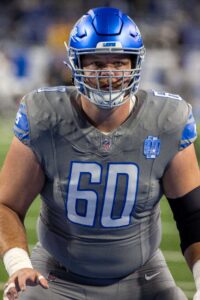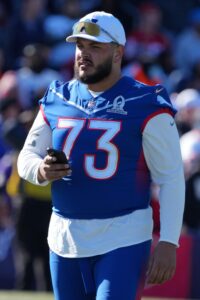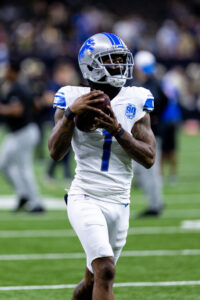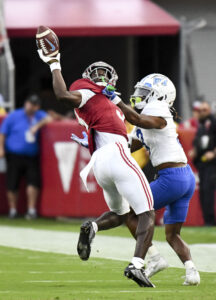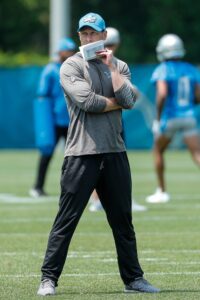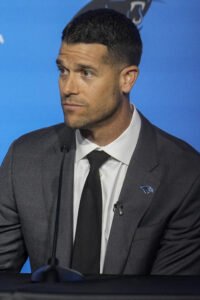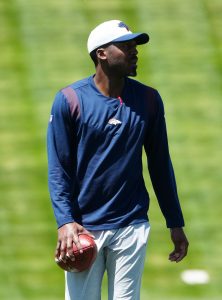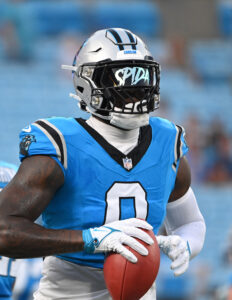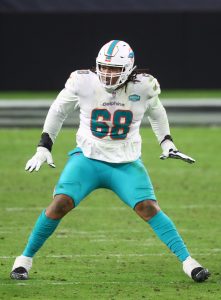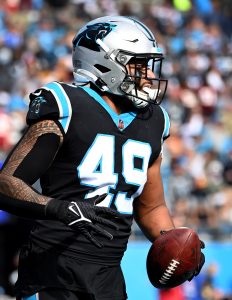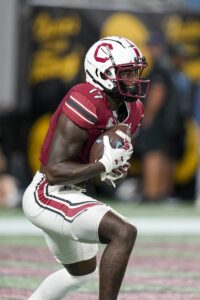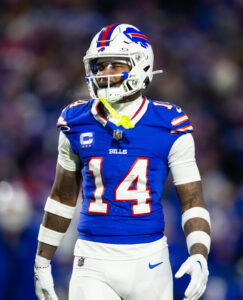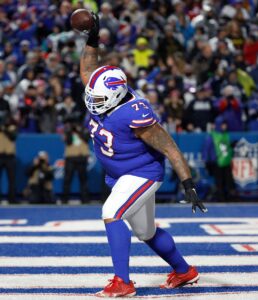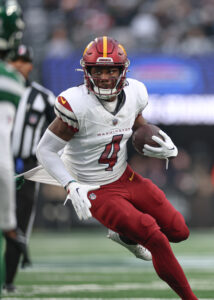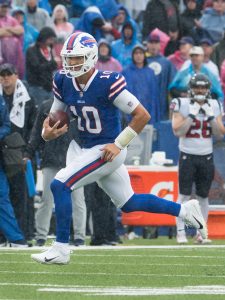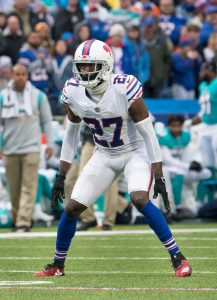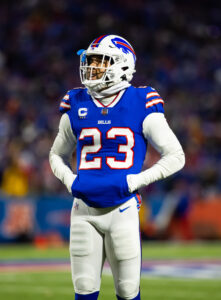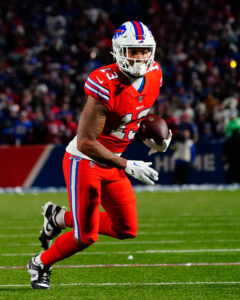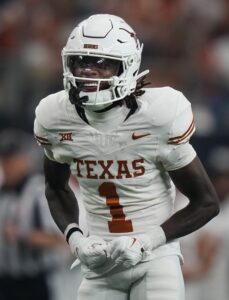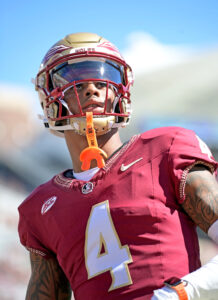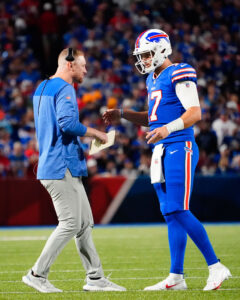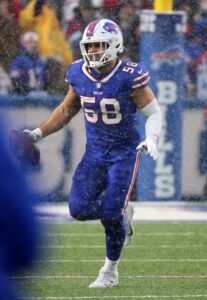Replacing the player most consider the greatest quarterback in NFL history, the Buccaneers also entered last season with more than $70MM in dead money — much if from Tom Brady‘s retirement — on their payroll. After the team defended its NFC South title and saw Baker Mayfield pilot a late-season charge, GM Jason Licht signed off on largely running it back in 2024.
While OC Dave Canales departed, Mayfield joined some Super Bowl-era cornerstones in recommitting to the Bucs. This effort, which included two record-setting extensions, will test how well the Bucs have built their roster. The team still plays in what again looks like the NFL’s worst division. It would surprise if this mass retention effort did not keep the Bucs a threat for a fourth straight home wild-card game.
Extensions and restructures:
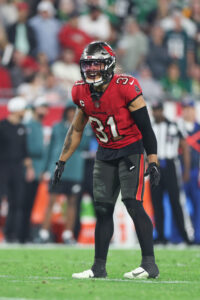 With the exception of the Bengals’ rental plans involving Tee Higgins, teams operated intently with their franchise- or transition-tagged players. While the Patriots used the transition tag on Kyle Dugger, the Bucs ensured Winfield could not test the market by slapping the franchise tag on the All-Pro. This turned out to be a significant offseason for the team’s breakthrough 2020 draft class, with pillars Winfield and Wirfs being locked down long term. Months before Wirfs’ payday, Winfield came in with a deal that tops all safeties and proved to outpace all cornerbacks as well.
With the exception of the Bengals’ rental plans involving Tee Higgins, teams operated intently with their franchise- or transition-tagged players. While the Patriots used the transition tag on Kyle Dugger, the Bucs ensured Winfield could not test the market by slapping the franchise tag on the All-Pro. This turned out to be a significant offseason for the team’s breakthrough 2020 draft class, with pillars Winfield and Wirfs being locked down long term. Months before Wirfs’ payday, Winfield came in with a deal that tops all safeties and proved to outpace all cornerbacks as well.
The safety market featured interesting twists this year. A host of veteran safeties — Justin Simmons and Quandre Diggs among them — became cap casualties. Many others settled for middle-class money as unrestricted free agents. As a market correction appeared in the works, the Packers gave Xavier McKinney a top-four safety deal. This brought good news for Winfield, who is a more accomplished safety. McKinney’s Green Bay deal reminded teams were still willing to pay up for the top young players at the position, and rumblings about Winfield requiring a record-setting extension surfaced soon after.
A 2020 second-round pick, Winfield became an immediate starter and helped the Bucs stonewall a historically explosive Chiefs offense in Super Bowl LV. The Bucs had expressed interest in extending the second-generation NFL DB in 2023, but Winfield ended up benefiting from the team waiting. He delivered a first-team All-Pro showing, complete with three interceptions, six sacks and an NFL-high six forced fumbles. The sixth of those strips denied DJ Chark at the goal line in a narrow Bucs Week 18 win over the Panthers, leading to a division title. Despite Mayfield and Mike Evans‘ free agencies, Winfield always loomed as Tampa Bay’s clear tag candidate.
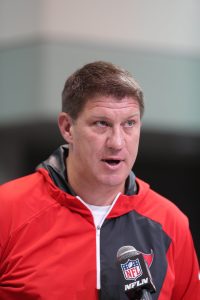 This pact checks in more than $2MM north of Derwin James‘ previous safety high-water mark, in terms of AAV, with the $21.03MM-per-year number also coming in higher than Jaire Alexander‘s CB record. In terms of guarantees at signing, Winfield’s $45MM separates him by $7MM from the safety pack. The threat of the Bucs tagging Winfield again in 2025 contributed to the team needing to go here to extend its top DB. Not hailed on the same level as Jamal Adams‘ 2021 extension that provided a gap between the then-Seahawks safety and the field, Winfield’s deal quietly accomplished this as well.
This pact checks in more than $2MM north of Derwin James‘ previous safety high-water mark, in terms of AAV, with the $21.03MM-per-year number also coming in higher than Jaire Alexander‘s CB record. In terms of guarantees at signing, Winfield’s $45MM separates him by $7MM from the safety pack. The threat of the Bucs tagging Winfield again in 2025 contributed to the team needing to go here to extend its top DB. Not hailed on the same level as Jamal Adams‘ 2021 extension that provided a gap between the then-Seahawks safety and the field, Winfield’s deal quietly accomplished this as well.
Going into free agency, Licht did not classify a 2024 Wirfs deal as a priority. After Tampa Bay checked its other top contract matters off the list, Wirfs made sure it became one. A spring report suggested the sides were far apart.
The Bucs had developed an atypical habit of waiting until after key players’ contracts expired to pay them. They did this with Shaq Barrett in 2021, Carlton Davis in 2022 and Jamel Dean last year. This trend continued in 2024, with Evans and Mayfield on the cusp of free agency before re-signing. Winfield also needed to be tagged, upon playing out his rookie deal. Wirfs staged a hold-in to force the team’s hand, and the Bucs deviated from their usual timeline.
 The Bucs saw the tackle market move before acting on Wirfs. While this may have cost the team a bit, this extension was actually early compared to when the team normally does business. Penei Sewell became the rare right tackle to reset the market for all tackles, scoring a $28MM-per-year Lions extension and the Vikings then gave Christian Darrisaw a deal that topped the LT market — at $26MM per.
The Bucs saw the tackle market move before acting on Wirfs. While this may have cost the team a bit, this extension was actually early compared to when the team normally does business. Penei Sewell became the rare right tackle to reset the market for all tackles, scoring a $28MM-per-year Lions extension and the Vikings then gave Christian Darrisaw a deal that topped the LT market — at $26MM per.
Wirfs, 25, is more accomplished than both, being a three-time Pro Bowler — at two different positions — and collecting first- and second-team All-Pro honors. Also helping Tampa Bay during its Brady years, Wirfs made a successful transition to the left side in 2023. Of the four tackles chosen in the top 13 picks in 2020, Wirfs — selected 13th overall — has been the best to date.
The Iowa product’s deal reflects this. The Bucs gave the fifth-year blocker $11MM more in guarantees ($88.2MM) than any other tackle. Tampa Bay did convince Wirfs to sign a five-year deal, but the contract does not tie Wirfs to his team for as long as Andrew Thomas‘ Giants pact does. Wirfs signed effectively a six-year commitment, whereas the Giants’ No. 4 overall pick in 2020 — who agreed to terms after his third season — gave his team seven years of control. Wirfs’ resolution matches the Lions’ Sewell term length, with the NFC North champs doing a deal following their RT’s third season.
With teams making significant updates to the tackle market this offseason, the NFL’s first $30MM-per-year tackle is likely coming soon.
Re-signings:
- Baker Mayfield, QB. Three years, $100MM ($40MM guaranteed)
- Mike Evans, WR. Two years, $41MM ($29MM guaranteed)
- Lavonte David, LB. One year, $8.5MM ($8.5MM guaranteed)
- Chase McLaughlin, K. Three years, $12.3MM ($5MM guaranteed)
- Greg Gaines, DT. One year, $3.5MM ($3MM guaranteed)
- William Gholston, DL. One year, $1.38MM ($985K guaranteed)
Value swings have defined Mayfield’s career. He went from an impressive rookie year that dragged the Browns out of the worst period in franchise history to enduring a major regression under overmatched HC Freddie Kitchens. The 2018 No. 1 overall pick then bounced back under Kevin Stefanski, giving the Browns their first playoff win since the franchise reboot. After Mayfield extension rumors did not produce serious negotiations in 2021, an early-season shoulder injury harpooned his value. The Browns then made their controversial (and financially damaging) Deshaun Watson trade, and Mayfield did not improve in Carolina, turning in his worst NFL season. That led to the Bucs nabbing him for $4MM; the sides’ second negotiation proved more complicated.
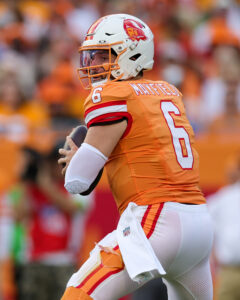 Mayfield needed to beat out Kyle Trask for the starting job, and Tampa Bay started 4-7. But the veteran showed flashes during the season’s first half and then piloted the team to a division-winning finish — likely saving Todd Bowles‘ job — and a wild-card romp over an Eagles team in crisis.
Mayfield needed to beat out Kyle Trask for the starting job, and Tampa Bay started 4-7. But the veteran showed flashes during the season’s first half and then piloted the team to a division-winning finish — likely saving Todd Bowles‘ job — and a wild-card romp over an Eagles team in crisis.
Mayfield, 29, had produced a better QBR with Stefanski, and his 54.3 number last year actually came in under his much-maligned 2019 season’s output (54.4). Mayfield ranked 18th in the metric in 2023. Under Canales, though, Mayfield finished with a career-high 28 TD passes (compared to 10 INTs). Following a 337-yard, three-TD showing against the Eagles, Mayfield held his own in Detroit in the divisional round (349/3, with two INTs) to better position himself for a higher-end 2024 contract.
The 2017 Heisman winner had said he wanted to stay with the Bucs, but they will have a harder time building around a $33.3MM-per-year contract than they did in 2023. That said, Brady’s $35.1MM dead money bill brought far more in combined QB cap allocations compared to where Mayfield’s money is this year ($6.9MM). Even after the current passer’s cap number spikes to $35.78MM in 2025, the ’23 Bucs still carried more in combined quarterback money on the payroll. With eight QBs now over $50MM per year and Dak Prescott set to become No. 9 soon or in 2025, Mayfield in this middle-class price range is not as player-friendly as the massive raise would suggest.
The sides completed a deal before free agency, and while loose Falcons and Patriots connections emerged, Mayfield never seemed close to leaving the team that revitalized his career. Barring an 11th-hour Prescott extension, Mayfield will enter the season as the NFL’s 19th-highest-paid quarterback. The seventh-year passer will see $10MM added to his guarantee total on Day 5 of the 2025 league year. It would cost the Bucs more than $26MM in dead money to bail before that date, giving the QB some security — though, not full-fledged assurances he will be back in 2025 — if another regression occurs.
 Discussions about the second-best wide receiver in Bucs history — for the handful of folks who have drifted far enough off path to address this matter — probably center on Chris Godwin, Kevin House, Mark Carrier or Vincent Jackson. The gap between this tier and Evans is rather wide.
Discussions about the second-best wide receiver in Bucs history — for the handful of folks who have drifted far enough off path to address this matter — probably center on Chris Godwin, Kevin House, Mark Carrier or Vincent Jackson. The gap between this tier and Evans is rather wide.
Making a Frank Gore-like Hall of Fame case based on consistency, Evans leads the Bucs in receiving by nearly 5,000 yards. The 10-time 1,000-yard receiver has been a modicum of consistency, providing high production baselines for Brady, Jameis Winston and Mayfield during his career. Evans does not have a first-team All-Pro honor on his resume (two second-team nods) and has surpassed 1,300 yards in a season just twice (2016, 2018), but he has been durable and did enough in 2023 to convince the Bucs to re-sign him — after a separation appeared in play.
Going public with frustration about his situation last August, Evans had confirmed the Bucs had not made an offer as the 2023 season neared. The decorated WR had seen the position’s market boom, while he remained tied to a $16.5MM-per-year deal he agreed to in 2018. That contract had plummeted toward the position’s middle class, with Godwin even surpassing it on his current $20MM-AAV accord. Evans matched the NFL lead in receiving TDs (13) last season, as the Bucs shut down trade inquiries. Rumblings about another Bucs deal surfaced, and the sides came together without the 2014 first-rounder reaching free agency.
 Evans, 31, had aimed to test the market and later said he would have considered the Chiefs or Texans if a viable Tampa Bay offer did not emerge. Instead, the Bucs gave their dependable pass catcher a frontloaded contract. In addition to the $29MM guaranteed at signing, another $6MM will come Evans’ way if he is on the Bucs’ roster on Day 5 of the 2025 league year. Barring a trade, he almost certainly will be. Regardless, Evans will almost definitely see all $41MM on this deal.
Evans, 31, had aimed to test the market and later said he would have considered the Chiefs or Texans if a viable Tampa Bay offer did not emerge. Instead, the Bucs gave their dependable pass catcher a frontloaded contract. In addition to the $29MM guaranteed at signing, another $6MM will come Evans’ way if he is on the Bucs’ roster on Day 5 of the 2025 league year. Barring a trade, he almost certainly will be. Regardless, Evans will almost definitely see all $41MM on this deal.
This is David’s fifth Bucs contract. As he continues to anchor the team’s second level, David ended up nearly doubling his 2023 contract (one year, $4.5MM) ahead of his age-34 season. The former second-round pick’s 134 tackles last season were his most since 2015 — his most recent Pro Bowl season, though the Bucs’ time in a 4-3 defense during the LB’s prime hurt his Pro Bowl count — and Pro Football Focus rated David as a top-25 off-ball ‘backer for the seventh straight year.
A one-team player, David had said it was Bucs or retirement this offseason. The Bucs will continue to lean on David, who trails only Ronde Barber and Derrick Brooks for Tampa Bay service time by a defender.
This is also Gholston’s fifth Bucs contract, as Licht’s retention approach did not only include higher-end contracts. Gholston has started 88 Bucs games, playing in 169. It is rare in today’s NFL when a 12th-year player is not his team’s longest-tenured defender, but David still holds that distinction. These two are the only remaining links to Bowles’ Super Bowl LV front seven. Gholston, 33, saw his playing time drop considerably in 2023; he played a career-low 244 defensive snaps. The Bucs still kept the veteran D-lineman around as a backup, with two recent early-round picks — starters Calijah Kancey, Logan Hall — to mentor.
Free agency additions:
- Jordan Whitehead, S. Two years, $9MM ($4.5MM guaranteed)
- Ben Bredeson, G. One year, $3MM ($1.75MM guaranteed)
- Chase Edmonds, RB. One year, $1.5MM ($1MM guaranteed)
- Tavierre Thomas, CB. One year, $1.5MM ($750K guaranteed)
- Sua Opeta, G. One year, $1.38MM ($650K guaranteed)
- Justin Skule, T. One year, $1.29MM ($600K guaranteed)
- Sterling Shepard, WR. Practice squad
Licht had bemoaned his decision to let Whitehead walk as a free agent in 2022, but the team did not operate with a full-on retention strategy the way it had in 2021. Whitehead, who started 55 games with the Bucs from 2018-21, played out a two-year, $14MM Jets deal. The Jets wanted to re-sign Whitehead but did not deem that a high priority. Whitehead is back in place as a safety starter, set to work alongside Winfield. From 2018-20, the Bucs used six second-, third- or fourth-round picks on DBs. Three remain with the team, as Dean continues on his 2023 re-up. Despite going into his seventh season, Whitehead is just 27.
Read more
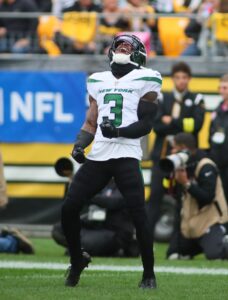 Bredeson has proven good enough to keep making his way into starting lineups. The Giants had expected the 2021 trade pickup to lose a competition to former third-rounder Joshua Ezeudu; Bredeson started 16 games last season. That came for an admittedly abysmal Giants O-line, and Bredeson’s market indeed underwhelmed. But he will take over as the team’s left guard starter.
Bredeson has proven good enough to keep making his way into starting lineups. The Giants had expected the 2021 trade pickup to lose a competition to former third-rounder Joshua Ezeudu; Bredeson started 16 games last season. That came for an admittedly abysmal Giants O-line, and Bredeson’s market indeed underwhelmed. But he will take over as the team’s left guard starter.
A former fourth-round Ravens draftee, Bredeson had been running ahead of Opeta before the latter’s ACL tear. He represents a low-cost solution for a Bucs team that just allocated record-setting cash to Wirfs. The team has displaced center Robert Hainsey and ex-Packers guard Royce Newman as insurance, as Bredeson is the only non-homegrown starter up front in Tampa. Opeta, who suffered a torn ACL, joins Edmonds in being out for the year.
Reuniting with Mayfield via a post-draft deal, Shepard is in place as insurance for a Bucs team that appears to have a clear-cut top three of Evans, Godwin and third-rounder Jalen McMillan. An Oklahoma alum who spent eight seasons with the Giants, Shepard was used sparingly last season (142 snaps) but did return to full strength after another major injury — a 2022 Achilles tear.
Notable losses:
- Shaq Barrett, OLB (post-June 1 cut)
- Dee Delaney, CB
- Matt Feiler, G
- Russell Gage, WR
- Randy Gregory, OLB (released)
- Ryan Jensen, C (retired)
- Nick Leverett, OL
- David Moore, WR
- Ryan Neal, S
- Deven Thompkins, WR (waived/injured)
- Devin White, ILB
 Two Super Bowl LV core performers, Barrett and Jensen are each done after 10-year careers. Each saw action in five Bucs seasons, with Jensen sidelined throughout the 2023 campaign after missing almost all of the ’22 slate.
Two Super Bowl LV core performers, Barrett and Jensen are each done after 10-year careers. Each saw action in five Bucs seasons, with Jensen sidelined throughout the 2023 campaign after missing almost all of the ’22 slate.
Barrett, who played five seasons with the Bucs, walked away after a brief stint with the Dolphins. The two-time Super Bowl winner — as a backup in Denver and a linchpin in Tampa — Barrett first became a Bucs cap casualty. Initially playing the odd role of comforting Licht as he made the transaction, Barrett had not looked quite himself in returning from an October 2022 Achilles tear. Barrett had ripped off a 37.5-sack surge from 2019-21. This stretch included an NFL sack crown (19.5 in 2019) and a lucrative 2021 re-signing. The payday came after the Bucs tagged Barrett in 2020 and after he made a Super Bowl MVP case by supplying relentless pressure on Patrick Mahomes.
The Bucs had restructured Barrett’s deal, increasing the Year 4 dead money. This transaction will leave behind considerable dead cap for two years. As a post-June 1 cut, Barrett will count $9.4MM in 2024 dead money and $17.4MM in 2025. His exit also leaves the Bucs with some questions at outside linebacker.
Jensen joined Carlton Davis in re-signing with the Bucs shortly after Brady unretired in 2022, but the veteran center was largely unable to reprise his role snapping to the all-time great. A severe knee injury sustained early during that year’s training camp sidelined Jensen throughout the regular season. While he returned to play in Tampa Bay’s wild-card matchup, the knee trouble ended his career a year later. Jensen had re-signed on a three-year, $39MM deal, but full MCL and PCL tears — along with ACL and meniscus damage — shut him down. A four-year Bucs starter, the ex-Ravens draftee started 65 games with his second NFL team. His knee trouble influenced Tampa Bay in the draft.
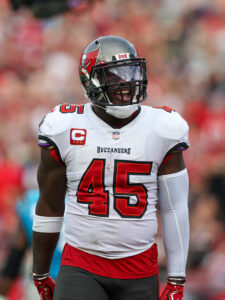 Flashing brightly at points, White saw his Bucs tenure ultimately disappoint. In one of the starker examples of a player miscalculating his value, White pushed for a top-five off-ball linebacker contract and requested a trade during the 2023 offseason. The Bucs not only balked there, but they ended up demoting the former top-five pick late in the season.
Flashing brightly at points, White saw his Bucs tenure ultimately disappoint. In one of the starker examples of a player miscalculating his value, White pushed for a top-five off-ball linebacker contract and requested a trade during the 2023 offseason. The Bucs not only balked there, but they ended up demoting the former top-five pick late in the season.
White had said his trade request altered his relationship with team brass. K.J. Britt cut into White’s playing time, after a strange injury subplot. Britt started over White in both Bucs playoff games, and the former second-team All-Pro — a player whose reputation proved incongruous to his advanced metrics — signed a one-year, $4MM Eagles deal. Britt, a 2021 fifth-rounder, is positioned to start alongside David.
Gregory’s Bucs tenure will slide to footnote territory, but it became a bizarre offseason storyline. Excepting Haason Reddick, most instances of a player not reporting to minicamp or training camp stem from a holdover upset about his contract. Gregory signed a one-year, $3MM deal in April but never showed up. Bowles had said he did not have any contact with the former Cowboys, Broncos and 49ers edge rusher, and the Bucs ended up cutting him days into his training camp holdout. Gregory had filed a lawsuit against the NFL and the Broncos regarding medication earlier this year and retired shortly after his Tampa no-show.
Trades:
 Re-signing Davis in 2022 and Dean in 2023, the Bucs split from one of their second-contract corners during the offseason that brought the Winfield and Wirfs megadeals. The Lions landed Davis before the Cameron Sutton drama and acquired a six-year starter whose contract expires at season’s end.
Re-signing Davis in 2022 and Dean in 2023, the Bucs split from one of their second-contract corners during the offseason that brought the Winfield and Wirfs megadeals. The Lions landed Davis before the Cameron Sutton drama and acquired a six-year starter whose contract expires at season’s end.
Tampa Bay’s Davis second-round choice in 2018 started the slew of DB investments in the draft; the first move gave the team a locked-in starter for a rather important period in team history. Teaming with Dean and Sean Murphy-Bunting, Davis commanded the top AAV ($15MM per year) on his second contract. Although Davis was charged with five touchdowns allowed in 2020, his passer rating-against numbers were stable, landing between 80-88 from 2019-22. Last year brought a slight step back, and PFF ranked Davis 68th at the position.
The Bucs have Dean signed through 2026, and they will lean on lower-cost complementary pieces rather than paying two CBs. Zyon McCollum, who struggled last season, and third-round rookie Tykee Smith are expected to join Dean as regulars.
Draft:
- Round 1, No. 26: Graham Barton (OL, Duke) (signed)
- Round 2, No. 57: Chris Braswell (EDGE, Alabama) (signed)
- Round 3, No. 89: Tykee Smith (S, Georgia) (signed)
- Round 3, No. 92 (from Lions): Jalen McMillan (WR, Washington) (signed)
- Round 4, No. 125: Bucky Irving (RB, Oregon) (signed)
- Round 6, No. 220: Elijah Klein (G, UTEP) (signed)
- Round 7, No. 246: Devin Culp (TE, Washington) (signed)
Tampa Bay had not devoted a first-round pick to an interior O-lineman since taking Davin Joseph in 2006. The team made Barton the first IOL taken in this year’s draft. Barton primarily played tackle at Duke, but he had long been viewed — unlike the Packers’ Jordan Morgan, who made a summer shift to guard — coming into the draft as a player who would line up inside as a pro.
 Barton had long been expected to start, and he indeed beat out Hainsey for the center job. Hainsey had started all 34 Bucs regular-season games following Jensen’s injury. PFF rated the former third-round pick as the league’s fifth-worst center regular last season, and the Bucs again used an early-round pick to bolster a front that had lost all its non-Wirfs starters from Super Bowl LV. After selecting RT Luke Goedeke in the 2022 second round and RG Cody Mauch in Round 2 last year, the Bucs now have four first- or second-round homegrown cogs up front. Barton earned back-to-back first-team All-ACC honors at left tackle but saw center work as a freshman back in 2020.
Barton had long been expected to start, and he indeed beat out Hainsey for the center job. Hainsey had started all 34 Bucs regular-season games following Jensen’s injury. PFF rated the former third-round pick as the league’s fifth-worst center regular last season, and the Bucs again used an early-round pick to bolster a front that had lost all its non-Wirfs starters from Super Bowl LV. After selecting RT Luke Goedeke in the 2022 second round and RG Cody Mauch in Round 2 last year, the Bucs now have four first- or second-round homegrown cogs up front. Barton earned back-to-back first-team All-ACC honors at left tackle but saw center work as a freshman back in 2020.
Gregory’s signing leading to retirement should accelerate Braswell’s time clock. With Joe Tryon-Shoyinka being benched last season, the Bucs need their second-round pick to play early. Both Bucs starters missed most of camp with injuries, and with YaYa Diaby replacing Tryon-Shoyinka opposite Barrett midway through last season, the 2021 first-rounder is on thin ice. Despite not working as a regular starter for Alabama, Braswell posted eight sacks (second on the team) and 10.5 tackles for loss. The Bucs, who had relied on outside acquisitions on the edge for a while, found a promising piece in Diaby. They need Braswell to follow suit.
Smith has beaten out 2023 slot Christian Izien for this year’s gig. This represents a quick ascent for the Georgia talent, who rounds out a starting secondary featuring five Bucs draft choices. A contributor on Georgia’s 2022 national championship team, Smith intercepted four passes and notched 8.5 tackles for loss last season. Izien remains on Tampa Bay’s roster, with Tavierre Thomas also having slot experience. The Bucs have some options in the event Smith is not ready.
Other:
 Canales went from a 12-year position coach who had never interviewed for a coordinator job before the 2023 offseason to a head coach on a six-year contract. The Panthers did not exactly have the best sales pitch for top-tier candidates, given their struggles under impulsive owner David Tepper, but the Buccaneers were able to coax far more out of Mayfield than Carolina thanks largely to Canales. After helping Geno Smith to Comeback Player of the Year acclaim as QBs coach, Canales jumped another rung on the ladder.
Canales went from a 12-year position coach who had never interviewed for a coordinator job before the 2023 offseason to a head coach on a six-year contract. The Panthers did not exactly have the best sales pitch for top-tier candidates, given their struggles under impulsive owner David Tepper, but the Buccaneers were able to coax far more out of Mayfield than Carolina thanks largely to Canales. After helping Geno Smith to Comeback Player of the Year acclaim as QBs coach, Canales jumped another rung on the ladder.
Coen happened to be the Rams’ OC when the operation fell apart in 2022. Injuries to Matthew Stafford, Cooper Kupp and most of the starting O-line plunged the team to 5-12 in 2022. He agreed to return to Kentucky before that season had ended. The Bears joined the Bucs in interviewing Coen; his second time leaving Kentucky’s OC post in three years will be to reunite with Mayfield. The 2022 waiver claim overlapped with Coen’s one-and-done Rams OC tenure, but this will be a new challenge for the successful college OC: an NFL play-calling gig.
The Rams ranked 27th in scoring and 32nd in yardage under Coen — by far their worst Sean McVay-era marks — but it is difficult to judge that due to the injury spree. Kentucky, however, yo-yoed from 36th under Coen in 2021 to 112th without him in 2022 (Will Levis‘ final season) to 58th last year. This is far from a home run hire, but the 38-year-old assistant does have more of an NFL past than his rough OC stint. He also served as a Rams staffer from 2018-20. The Bucs memorably gave Mayfield a say in their OC search before he had re-signed, giving a good indication of the team’s 2024 QB plan.
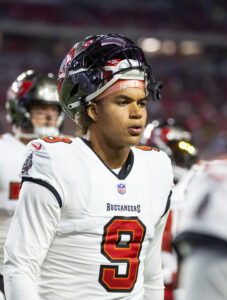 Armstrong, Goodwin and Gilbert both stayed on as Bruce Arians hires, with Idzik jumping from one season in charge of a position to an OC post. Idzik had previously been the Seahawks’ assistant WRs coach before following Canales to Tampa in 2023. Tom Moore, 85, remains in the consulting role Arians tabbed him for, however.
Armstrong, Goodwin and Gilbert both stayed on as Bruce Arians hires, with Idzik jumping from one season in charge of a position to an OC post. Idzik had previously been the Seahawks’ assistant WRs coach before following Canales to Tampa in 2023. Tom Moore, 85, remains in the consulting role Arians tabbed him for, however.
Hoping to land a quality Jason Pierre-Paul successor, the Bucs have not seen Tryon-Shoyinka fit the bill yet. As a 16-game starter in 2022, the Washington alum did produce 14 QB hits in a four-sack season. In 17 games last year, however, the young edge defender compiled just seven QB hits. The Bucs benched him for eventual team sack leader Diaby after Week 12.
Considering Tryon-Shoyinka’s uninspiring first three seasons, it represents a clear gamble for the Bucs to try him as a starter once again. Now in a contract year, the 25-year-old pass rusher enters a fork-in-the-road season as a pro.
Top 10 cap charges for 2024:
- Chris Godwin, WR: $27.53MM
- Vita Vea, DT: $20.53MM
- Jamel Dean, CB: $14.67MM
- Lavonte David, LB: $8.5MM
- Antoine Winfield Jr., S: $8MM
- Baker Mayfield, QB: $6.9MM
- Tristan Wirfs, LT: $6.61MM
- Mike Evans, WR: $5.57MM
- Anthony Nelson, OLB: $5.38MM
- Chase McLaughlin, K: $5MM
Were the Buccaneers right to invest so heavily in their own acquisitions this offseason, or should this roster be a bit more diverse? The Colts took some heat for Chris Ballard‘s reinvestment penchant this year, but Licht’s team is projected to start all of two players (Mayfield, Bredeson) who were not Bucs draft picks. Plenty of confidence exists in a nucleus that tumbled off the Super Bowl radar after Tom Brady‘s penultimate season.
This formula still should be good enough to make another push to win the NFC South. The Falcons will be more imposing this season, but the Saints look to be putting off a necessary rebuild. The Panthers do not appear an immediate threat, and the NFC has produced an 8-8 or 9-8 No. 7 seed each year since the 2020 playoff expansion.
The Bucs should be in the mix, and they do not have Brady’s dead money figure on the books any longer. They are showing plenty of faith in an operation that has gone 17-17 under Bowles. The Coen-Mayfield setup will play the biggest role in determining if upward mobility exists for Bowles’ third roster.
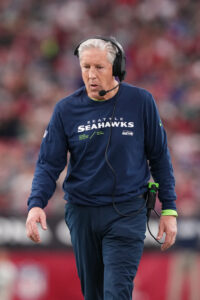 Another case can be made the Seahawks were not the same team once they gave Wilson the first of his three extensions. The Seahawks made the playoffs five times from 2015-20. They won three wild-card games in that span, but they partially benefited from Blair Walsh‘s 27-yard missed field goal (2015) and Carson Wentz sustaining an early concussion (2019). The Lions team they topped in 2016 also ranked 27th in DVOA. This is not to say those Seahawk editions were not worthy playoff squads, but the franchise’s post-Super Bowl XLIX period saw regular check-ins as a second-tier contender. No conference championship appearances have followed since the infamous Marshawn Lynch “what if?”
Another case can be made the Seahawks were not the same team once they gave Wilson the first of his three extensions. The Seahawks made the playoffs five times from 2015-20. They won three wild-card games in that span, but they partially benefited from Blair Walsh‘s 27-yard missed field goal (2015) and Carson Wentz sustaining an early concussion (2019). The Lions team they topped in 2016 also ranked 27th in DVOA. This is not to say those Seahawk editions were not worthy playoff squads, but the franchise’s post-Super Bowl XLIX period saw regular check-ins as a second-tier contender. No conference championship appearances have followed since the infamous Marshawn Lynch “what if?”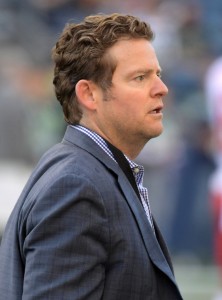 Carroll had tried to keep the job, but a report also suggested he had made midseason comments about retirement. Carroll’s specialty, Seattle’s defense proved a letdown during the team’s second straight 9-8 season. Struggling in particular against the run, Carroll and Clint Hurtt‘s unit ranked 25th in scoring and 28th in DVOA. Enter Macdonald, who coaxed the Ravens to a No. 1 defensive ranking despite late-summer (Jadeveon Clowney) or in-season (Kyle Van Noy) additions in place as the team’s top edge rushers. Baltimore led the league in defensive DVOA, and the ex-Jim Harbaugh Michigan DC received an early chance at a top NFL job.
Carroll had tried to keep the job, but a report also suggested he had made midseason comments about retirement. Carroll’s specialty, Seattle’s defense proved a letdown during the team’s second straight 9-8 season. Struggling in particular against the run, Carroll and Clint Hurtt‘s unit ranked 25th in scoring and 28th in DVOA. Enter Macdonald, who coaxed the Ravens to a No. 1 defensive ranking despite late-summer (Jadeveon Clowney) or in-season (Kyle Van Noy) additions in place as the team’s top edge rushers. Baltimore led the league in defensive DVOA, and the ex-Jim Harbaugh Michigan DC received an early chance at a top NFL job.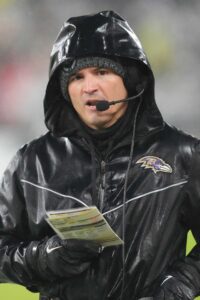 Schematic changes will be evident immediately in Seattle, and it will be interesting to see how Smith looks in Grubb’s offense. Macdonald kept the Ravens’ long-running 3-4 scheme in place but hired Durde, who had served as the Cowboys’ D-line coach under Quinn. Durde joined Macdonald as an in-demand candidate. The Falcons, Rams and Packers requested meetings, and the Cowboys interviewed him for their DC post — one that ended up going to Mike Zimmer — after the Commanders poached Joe Whitt. Macdonald also considered ex-Ravens coworker Zach Orr, but he received a Baltimore promotion.
Schematic changes will be evident immediately in Seattle, and it will be interesting to see how Smith looks in Grubb’s offense. Macdonald kept the Ravens’ long-running 3-4 scheme in place but hired Durde, who had served as the Cowboys’ D-line coach under Quinn. Durde joined Macdonald as an in-demand candidate. The Falcons, Rams and Packers requested meetings, and the Cowboys interviewed him for their DC post — one that ended up going to Mike Zimmer — after the Commanders poached Joe Whitt. Macdonald also considered ex-Ravens coworker Zach Orr, but he received a Baltimore promotion. The Seahawks sent the Giants second- and fifth-round picks for Williams at the 2023 deadline. Hours after the Giants then sent second- and fifth-rounders for Brian Burns, the Seahawks did not let the asset they had acquired leave. Williams is back in the fold, representing a shift for a Seahawks team that continues to invest along the D-line after previously not devoting substantial resources — at least, not until the 2023 Dre’Mont Jones signing — to interior defensive linemen. Jones has since been working on the edge, even after spending five seasons as an interior rusher. Through that lens, the Seahawks have an inside-outside rush combo each on contracts north of $17MM per year.
The Seahawks sent the Giants second- and fifth-round picks for Williams at the 2023 deadline. Hours after the Giants then sent second- and fifth-rounders for Brian Burns, the Seahawks did not let the asset they had acquired leave. Williams is back in the fold, representing a shift for a Seahawks team that continues to invest along the D-line after previously not devoting substantial resources — at least, not until the 2023 Dre’Mont Jones signing — to interior defensive linemen. Jones has since been working on the edge, even after spending five seasons as an interior rusher. Through that lens, the Seahawks have an inside-outside rush combo each on contracts north of $17MM per year. Fant joined Williams in hitting the market. Early deals for Dalton Schultz and Hunter Henry helped the 2019 first-round pick, but his Seahawks usage did not create an extensive bidding war. Fant drew 93- and 90-target seasons during his final two Broncos years; after seeing 63 looks in his Seahawks debut, the Iowa product commanded a paltry 43 last season. After 670- and 673-yard showings in offenses with sub-average QB play in Denver, Fant has stalled out in Seattle. This contract, however, would appear to show the team agrees a production uptick should be expected.
Fant joined Williams in hitting the market. Early deals for Dalton Schultz and Hunter Henry helped the 2019 first-round pick, but his Seahawks usage did not create an extensive bidding war. Fant drew 93- and 90-target seasons during his final two Broncos years; after seeing 63 looks in his Seahawks debut, the Iowa product commanded a paltry 43 last season. After 670- and 673-yard showings in offenses with sub-average QB play in Denver, Fant has stalled out in Seattle. This contract, however, would appear to show the team agrees a production uptick should be expected.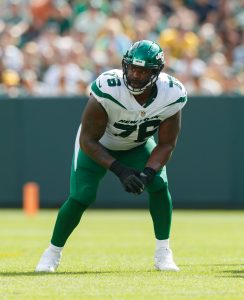 AFC East fans will recognize several players in this year’s Seahawks starting lineup. Most of the main additions come from that division.
AFC East fans will recognize several players in this year’s Seahawks starting lineup. Most of the main additions come from that division.